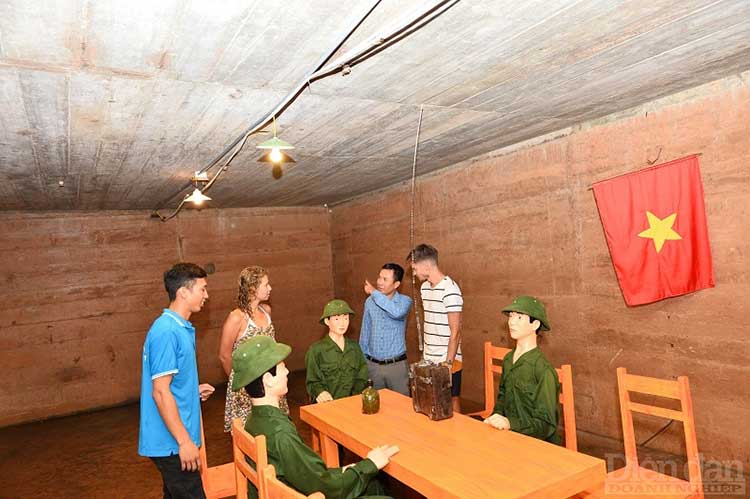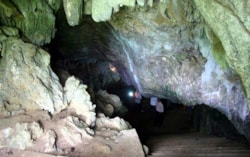1. Where Is Hospital Cave
Hospital Cave is situated along the cross-island road, approximately 7 km from Cat Ba town. Found in Hai Son village, formerly known as Khe Sau, within Tran Chau commune, Cat Hai district, Hai Phong city.
Constructed during the tumultuous days of the resistance war against the United States, this site stands as a testament to our nation's heroic resistance against the invaders, bearing witness to the unwavering struggle of our people.

2. History of Hospital cave
At first, Hospital cave was initially recognized as Hung Son cave. However, it underwent a transformation during the years of 1963 to 1965 when the United States invaded North Vietnam. This limestone cave underwent renovations to serve as a field hospital, marking a pivotal moment in its history.
In its earlier iteration, the staircase was constructed from wood and strategically destroyed during enemy attacks to hinder their advancement into the cave. Post-war, the stairs were rebuilt and repurposed into a tourist destination, inviting visitors to discover its historical significance.
3. How to get to Hospital Cave
To reach Cat Ba Military Medicine Cave, visitors initially need to select a mode of transportation to get to Cat Ba in Hai Phong. There's a wide range of options for tourists coming from Hanoi and northern provinces, including trains, motorbikes, cars, or buses.
Upon reaching Hai Phong, make your way to the heart of Cat Ba town. From there, follow the route leading to Cai Vieng ferry terminal, then continue along Cat Tien street. Progress through 1/4 street, Tung Dinh street, and Tung Thu street to finally arrive at the entrance of Quan Y Cave.
Hospital cave entrance fee & opening hours
Visitors have the flexibility to choose the time of day that suits them best for exploring the cave.
>>> Read more: How to get to Cat Ba
3. Hospital cave opening hours
Opening hours: from 8 am to 5 pm (every day)
Entrance fee: $1.5 per person, free parking.

4. What to do and see at hospital cave
Observing from the exterior, the cave boasts a lofty ceiling adorned with patches of green moss clinging to the rocks, creating an air of mystery.
The cave is structured into three floors, but visitors are restricted to exploring only the first two floors. The pathway to the third floor is deemed perilous, prompting the installation of a barrier to ensure the safety of tourists and prevent accidental falls.
The first floor
Right at the entrance of the cave, visitors will encounter a uniquely designed iron door. This curved door bulges in the middle and gradually tapers on both sides, ingeniously causing bombs and bullets aimed at it to deflect to protect the door from damage.
The first floor is meticulously divided into various sections, including meeting rooms, ammunition storage rooms, treatment rooms, serving as the direct living area for the soldiers. Within these rooms, visitors can find soldier models and artifacts left from the war.
The second and third floor
At the end of the hallway on the first floor, a small path leads to the second floor.
The second and third floors largely maintain the natural stone cave structure, featuring varied cave domes—some high and others quite low—utilized as spaces for soldier training and testing physical strength.
Notably, a mural on the upper level portrays 10 female soldiers bravely wielding AK47s, symbolizing their fearless act of downing an enemy B52 plane. This depiction stands as a testament to the courage of Hai Phong women, demonstrating their resilience against formidable foes.
>>> Read more: Best things to do in Cat Ba

Hospital cave facts
Do you know about these interesting facts?
-
Inside the Quan Y cave, there are up to 17 patient rooms along with many other functional rooms.
-
It can serve more than 100 people.
-
Hospital cave has a total of 3 floors with an area of more than 2,000 m2.
-
You can admire the cave in a state that is almost 100% similar to the past state during the resistance period.
5. Extra tips
For an optimal visit to Cat Ba's Quan Y Cave, it is advisable for tourists to schedule their trip between March and October. During this period, the weather is delightful with minimal rain, making it convenient for both transportation to the cave and exploration within it.
Moreover, the lighting in the Hospital cave can be somewhat dim, requiring the use of a flashlight or phone light in certain areas for clearer visibility.
Overall, Hospital Cave stands as a poignant testament to the wartime history of Vietnam. Embarking on your journey here will be imbued with a sense of purpose and fulfillment!

